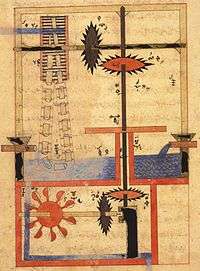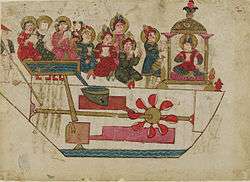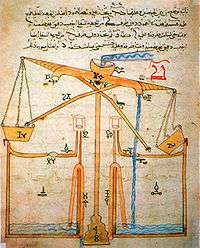Mechanics
Mechanics (Greek μηχανική) is the area of physics concerned with the motions of macroscopic objects. Forces applied to objects result in displacements, or changes of an object's position relative to its environment. This branch of physics has its origins in Ancient Greece with the writings of Aristotle and Archimedes[1][2][3] (see History of classical mechanics and Timeline of classical mechanics). During the early modern period, scientists such as Galileo, Kepler, and Newton laid the foundation for what is now known as classical mechanics. It is a branch of classical physics that deals with particles that are either at rest or are moving with velocities significantly less than the speed of light. It can also be defined as a branch of science which deals with the motion of and forces on bodies not in the quantum realm. The field is today less widely understood in terms of quantum theory.
Classical versus quantum
| Part of a series of articles about |
| Classical mechanics |
|---|
|
|
Branches
|
|
Fundamentals
|
|
Formulations
|
|
Core topics
|
|
Rotation
|
|
Categories ► Classical mechanics |
| Part of a series on |
| Quantum mechanics |
|---|
|
|
Background
|
|
Fundamentals
|
|
Effects
|
|
Experiments
|
|
Formulations
|
|
Equations
|
|
Interpretations
|
|
Advanced topics
|
|
Scientists
|
|
Categories ► Quantum mechanics |
Historically, classical mechanics came first and quantum mechanics is a comparatively recent development. Classical mechanics originated with Isaac Newton's laws of motion in Philosophiæ Naturalis Principia Mathematica; Quantum Mechanics was developed in the early 20th century. Both are commonly held to constitute the most certain knowledge that exists about physical nature.
Classical mechanics has especially often been viewed as a model for other so-called exact sciences. Essential in this respect is the extensive use of mathematics in theories, as well as the decisive role played by experiment in generating and testing them.
Quantum mechanics is of a bigger scope, as it encompasses classical mechanics as a sub-discipline which applies under certain restricted circumstances. According to the correspondence principle, there is no contradiction or conflict between the two subjects, each simply pertains to specific situations. The correspondence principle states that the behavior of systems described by quantum theories reproduces classical physics in the limit of large quantum numbers. Quantum mechanics has superseded classical mechanics at the foundation level and is indispensable for the explanation and prediction of processes at the molecular, atomic, and sub-atomic level. However, for macroscopic processes classical mechanics is able to solve problems which are unmanageably difficult in quantum mechanics and hence remains useful and well used. Modern descriptions of such behavior begin with a careful definition of such quantities as displacement (distance moved), time, velocity, acceleration, mass, and force. Until about 400 years ago, however, motion was explained from a very different point of view. For example, following the ideas of Greek philosopher and scientist Aristotle, scientists reasoned that a cannonball falls down because its natural position is in the Earth; the sun, the moon, and the stars travel in circles around the earth because it is the nature of heavenly objects to travel in perfect circles.
Often cited as father to modern science, Galileo brought together the ideas of other great thinkers of his time and began to calculate motion in terms of distance travelled from some starting position and the time that it took. He showed that the speed of falling objects increases steadily during the time of their fall. This acceleration is the same for heavy objects as for light ones, provided air friction (air resistance) is discounted. The English mathematician and physicist Isaac Newton improved this analysis by defining force and mass and relating these to acceleration. For objects traveling at speeds close to the speed of light, Newton's laws were superseded by Albert Einstein’s theory of relativity. [A sentence illustrating the computational complication of Einstein's theory of relativity.] For atomic and subatomic particles, Newton's laws were superseded by quantum theory. For everyday phenomena, however, Newton's three laws of motion remain the cornerstone of dynamics, which is the study of what causes motion.
Relativistic versus Newtonian
In analogy to the distinction between quantum and classical mechanics, Einstein's general and special theories of relativity have expanded the scope of Newton and Galileo's formulation of mechanics. The differences between relativistic and Newtonian mechanics become significant and even dominant as the velocity of a massive body approaches the speed of light. For instance, in Newtonian mechanics, Newton's laws of motion specify that F = ma, whereas in relativistic mechanics and Lorentz transformations, which were first discovered by Hendrik Lorentz, F = γma (where γ is the Lorentz factor, which is almost equal to 1 for low speeds).
General relativistic versus quantum
Relativistic corrections are also needed for quantum mechanics, although general relativity has not been integrated. The two theories remain incompatible, a hurdle which must be overcome in developing a theory of everything.
History
Antiquity
The main theory of mechanics in antiquity was Aristotelian mechanics.[4] A later developer in this tradition is Hipparchus.[5]
Medieval age



In the Middle Ages, Aristotle's theories were criticized and modified by a number of figures, beginning with John Philoponus in the 6th century. A central problem was that of projectile motion, which was discussed by Hipparchus and Philoponus.
Persian Islamic polymath Ibn Sīnā published his theory of motion in The Book of Healing (1020). He said that an impetus is imparted to a projectile by the thrower, and viewed it as persistent, requiring external forces such as air resistance to dissipate it.[6][7][8] Ibn Sina made distinction between 'force' and 'inclination' (called "mayl"), and argued that an object gained mayl when the object is in opposition to its natural motion. So he concluded that continuation of motion is attributed to the inclination that is transferred to the object, and that object will be in motion until the mayl is spent. He also claimed that projectile in a vacuum would not stop unless it is acted upon. This conception of motion is consistent with Newton's first law of motion, inertia. Which states that an object in motion will stay in motion unless it is acted on by an external force.[9] This idea which dissented from the Aristotelian view was later described as "impetus" by John Buridan, who was influenced by Ibn Sina's Book of Healing.[10]
On the question of a body subject to a constant (uniform) force, the 12th-century Jewish-Arab scholar Hibat Allah Abu'l-Barakat al-Baghdaadi (born Nathanel, Iraqi, of Baghdad) stated that constant force imparts constant acceleration. According to Shlomo Pines, al-Baghdaadi's theory of motion was "the oldest negation of Aristotle's fundamental dynamic law [namely, that a constant force produces a uniform motion], [and is thus an] anticipation in a vague fashion of the fundamental law of classical mechanics [namely, that a force applied continuously produces acceleration]."[11] The same century, Ibn Bajjah proposed that for every force there is always a reaction force. While he did not specify that these forces be equal, it is still an early version of the third law of motion which states that for every action there is an equal and opposite reaction.[12]
Influenced by earlier writers such as Ibn Sina[10] and al-Baghdaadi,[13] the 14th-century French priest Jean Buridan developed the theory of impetus, which later developed into the modern theories of inertia, velocity, acceleration and momentum. This work and others was developed in 14th-century England by the Oxford Calculators such as Thomas Bradwardine, who studied and formulated various laws regarding falling bodies. The concept that the main properties of a body are uniformly accelerated motion (as of falling bodies) was worked out by the 14th-century Oxford Calculators.
Early modern age
Two central figures in the early modern age are Galileo Galilei and Isaac Newton. Galileo's final statement of his mechanics, particularly of falling bodies, is his Two New Sciences (1638). Newton's 1687 Philosophiæ Naturalis Principia Mathematica provided a detailed mathematical account of mechanics, using the newly developed mathematics of calculus and providing the basis of Newtonian mechanics.[5]
There is some dispute over priority of various ideas: Newton's Principia is certainly the seminal work and has been tremendously influential, and the systematic mathematics therein did not and could not have been stated earlier because calculus had not been developed. However, many of the ideas, particularly as pertain to inertia (impetus) and falling bodies had been developed and stated by earlier researchers, both the then-recent Galileo and the less-known medieval predecessors. Precise credit is at times difficult or contentious because scientific language and standards of proof changed, so whether medieval statements are equivalent to modern statements or sufficient proof, or instead similar to modern statements and hypotheses is often debatable.
Modern age
Two main modern developments in mechanics are general relativity of Einstein, and quantum mechanics, both developed in the 20th century based in part on earlier 19th-century ideas. The development in the modern continuum mechanics, particularly in the areas of elasticity, plasticity, fluid dynamics, electrodynamics and thermodynamics of deformable media, started in the second half of the 20th century.
Types of mechanical bodies
The often-used term body needs to stand for a wide assortment of objects, including particles, projectiles, spacecraft, stars, parts of machinery, parts of solids, parts of fluids (gases and liquids), etc.
Other distinctions between the various sub-disciplines of mechanics, concern the nature of the bodies being described. Particles are bodies with little (known) internal structure, treated as mathematical points in classical mechanics. Rigid bodies have size and shape, but retain a simplicity close to that of the particle, adding just a few so-called degrees of freedom, such as orientation in space.
Otherwise, bodies may be semi-rigid, i.e. elastic, or non-rigid, i.e. fluid. These subjects have both classical and quantum divisions of study.
For instance, the motion of a spacecraft, regarding its orbit and attitude (rotation), is described by the relativistic theory of classical mechanics, while the analogous movements of an atomic nucleus are described by quantum mechanics.
Sub - disciplines
The following are two lists of various subjects that are studied in mechanics.
Note that there is also the "theory of fields" which constitutes a separate discipline in physics, formally treated as distinct from mechanics, whether classical fields or quantum fields. But in actual practice, subjects belonging to mechanics and fields are closely interwoven. Thus, for instance, forces that act on particles are frequently derived from fields (electromagnetic or gravitational), and particles generate fields by acting as sources. In fact, in quantum mechanics, particles themselves are fields, as described theoretically by the wave function.
Classical
The following are described as forming classical mechanics:
- Newtonian mechanics, the original theory of motion (kinematics) and forces (dynamics).
- Analytical mechanics is a reformulation of Newtonian mechanics with an emphasis on system energy, rather than on forces. There are two main branches of analytical mechanics:
- Hamiltonian mechanics, a theoretical formalism, based on the principle of conservation of energy.
- Lagrangian mechanics, another theoretical formalism, based on the principle of the least action.
- Classical statistical mechanics generalizes ordinary classical mechanics to consider systems in an unknown state; often used to derive thermodynamic properties.
- Celestial mechanics, the motion of bodies in space: planets, comets, stars, galaxies, etc.
- Astrodynamics, spacecraft navigation, etc.
- Solid mechanics, elasticity, plasticity, viscoelasticity exhibited by deformable solids.
- Fracture mechanics
- Acoustics, sound ( = density variation propagation) in solids, fluids and gases.
- Statics, semi-rigid bodies in mechanical equilibrium
- Fluid mechanics, the motion of fluids
- Soil mechanics, mechanical behavior of soils
- Continuum mechanics, mechanics of continua (both solid and fluid)
- Hydraulics, mechanical properties of liquids
- Fluid statics, liquids in equilibrium
- Applied mechanics, or Engineering mechanics
- Biomechanics, solids, fluids, etc. in biology
- Biophysics, physical processes in living organisms
- Relativistic or Einsteinian mechanics, universal gravitation.
Quantum
The following are categorized as being part of quantum mechanics:
- Schrödinger wave mechanics, used to describe the movements of the wavefunction of a single particle.
- Matrix mechanics is an alternative formulation that allows considering systems with a finite-dimensional state space.
- Quantum statistical mechanics generalizes ordinary quantum mechanics to consider systems in an unknown state; often used to derive thermodynamic properties.
- Particle physics, the motion, structure, and reactions of particles
- Nuclear physics, the motion, structure, and reactions of nuclei
- Condensed matter physics, quantum gases, solids, liquids, etc.
Professional organizations
- Applied Mechanics Division, American Society of Mechanical Engineers
- Fluid Dynamics Division, American Physical Society
- Society for Experimental Mechanics
- Institution of Mechanical Engineers is the United Kingdom's qualifying body for Mechanical Engineers and has been the home of Mechanical Engineers for over 150 years.
- International Union of Theoretical and Applied Mechanics
See also
- Applied mechanics
- Dynamics
- Engineering
- Index of engineering science and mechanics articles
- Kinematics
- Kinetics
- Non-autonomous mechanics
- Statics
- Wiesen Test of Mechanical Aptitude (WTMA)
References
- Dugas, Rene. A History of Classical Mechanics. New York, NY: Dover Publications Inc, 1988, pg 19.
- Rana, N.C., and Joag, P.S. Classical Mechanics. West Petal Nagar, New Delhi. Tata McGraw-Hill, 1991, pg 6.
- Renn, J., Damerow, P., and McLaughlin, P. Aristotle, Archimedes, Euclid, and the Origin of Mechanics: The Perspective of Historical Epistemology. Berlin: Max Planck Institute for the History of Science, 2010, pg 1-2.
- "A history of mechanics". René Dugas (1988). p.19. ISBN 0-486-65632-2
- "A Tiny Taste of the History of Mechanics". The University of Texas at Austin.
- Espinoza, Fernando (2005). "An analysis of the historical development of ideas about motion and its implications for teaching". Physics Education. 40 (2): 141. Bibcode:2005PhyEd..40..139E. doi:10.1088/0031-9120/40/2/002.
- Seyyed Hossein Nasr & Mehdi Amin Razavi (1996). The Islamic intellectual tradition in Persia. Routledge. p. 72. ISBN 978-0-7007-0314-2.
- Aydin Sayili (1987). "Ibn Sīnā and Buridan on the Motion of the Projectile". Annals of the New York Academy of Sciences. 500 (1): 477–482. Bibcode:1987NYASA.500..477S. doi:10.1111/j.1749-6632.1987.tb37219.x.
- Espinoza, Fernando. "An Analysis of the Historical Development of Ideas About Motion and its Implications for Teaching". Physics Education. Vol. 40(2).
- Sayili, Aydin. "Ibn Sina and Buridan on the Motion the Projectile". Annals of the New York Academy of Sciences vol. 500(1). p.477-482.
- Pines, Shlomo (1970). "Abu'l-Barakāt al-Baghdādī , Hibat Allah". Dictionary of Scientific Biography. 1. New York: Charles Scribner's Sons. pp. 26–28. ISBN 0-684-10114-9.
(cf. Abel B. Franco (October 2003). "Avempace, Projectile Motion, and Impetus Theory", Journal of the History of Ideas 64 (4), p. 521-546 [528].) - Franco, Abel B.. "Avempace, Projectile Motion, and Impetus Theory". Journal of the History of Ideas. Vol. 64(4): 543.
- Gutman, Oliver (2003), Pseudo-Avicenna, Liber Celi Et Mundi: A Critical Edition, Brill Publishers, p. 193, ISBN 90-04-13228-7
- Walter Lewin (October 4, 1999). Work, Energy, and Universal Gravitation. MIT Course 8.01: Classical Mechanics, Lecture 11 (ogg) (videotape). Cambridge, MA US: MIT OCW. Event occurs at 1:21-10:10. Retrieved December 23, 2010.
Further reading
- Robert Stawell Ball (1871) Experimental Mechanics from Google books.
- Landau, L. D.; Lifshitz, E. M. (1972). Mechanics and Electrodynamics, Vol. 1. Franklin Book Company, Inc. ISBN 978-0-08-016739-8.
External links
| Look up mechanics in Wiktionary, the free dictionary. |
- iMechanica: the web of mechanics and mechanicians
- Mechanics Definition
- Mechanics Blog by a Purdue University Professor
- The Mechanics program at Virginia Tech
- Physclips: Mechanics with animations and video clips from the University of New South Wales
- U.S. National Committee on Theoretical and Applied Mechanics
- Interactive learning resources for teaching Mechanics
- The Archimedes Project